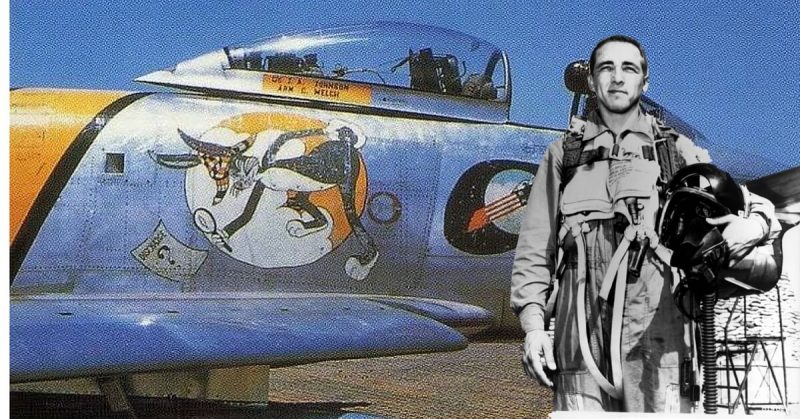
James Robinson “Robbie ” Risner was an American military pilot, a double recipient of the Air Force Cross and a hero of the Korean and Vietnam War. Born on January 16th, 1925, to a poor Arkansas family, Risner struggled throughout his childhood, working from an early age, to contribute to his household. He soon moved with his family to Oklahoma.
By the time he was in high school, Risner had already had a string of jobs, working in newspapers delivery, as an errand boy, an assistant in a drug-store, and as a welder. When his father managed to develop a business selling used cars, Risner helped polish them. He received a religious upbringing as a member of the 1st Assembly of God Church.
In his youth, James Risner was fascinated with two things ― horses and motorcycles. Both of these passions would play an important role further in his life. He enlisted in the United States Army Air Forces in 1943, finishing his training in 1944 with the rank of a 2nd Lieutenant. After flight school, Risner was transferred to Panama, to serve as part of the 30th Fighter Squadron. In 1946, while pursuing his passion for motorcycles, he had an off-duty accident, which landed him in an Army hospital. There he met Kathleen Shaw, a nurse who took care of him. The two were discharged from the Army and got married soon afterwards.
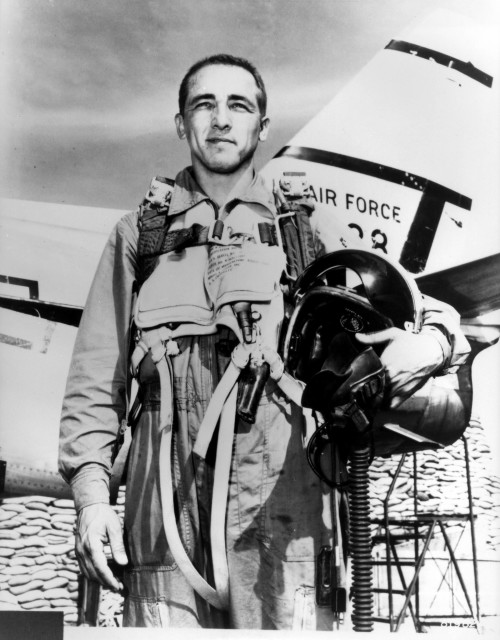
During his civilian life, James Risner didn’t have much luck in keeping a job. He joined the Oklahoma Air National Guard, where he could frequently fly, using the Air National Guard’s P-51 Mustang Plane, which kept him in flying shape. On one occasion, he was caught up in a hurricane and was forced to land, only later realising that he landed on Mexican territory. He had a brief encounter with some bandits, which ended well for him and he managed to fly back to the States. He received an unofficial rebuke from the American embassy for flying an armed fighter into the sovereign territory of a foreign nation, but for diplomatic reasons the flight was officially ignored.
Korean War
When the Korean War broke out, he was happy to join the Air Force once again. Risner got a recall to active duty in February 1951 and was attached to the 185th Tactical Fighter Squadron in Oklahoma. He was subsequently trained to use F-80 Shooting Star, the first American operational jet fighter, designed during WWII, but used actively in Korea.On the last day before going overseas, Risner fell off a horse and broke his arm ― once again, faith interfered with his passion. James Robinson didn’t let the injury stop him from seeing action, so he concealed the wound that would get him grounded. He managed to convince a surgeon that the wound had healed, even though he took the cast off himself, to fly his first combat mission.
On May 10th, 1952, Risner was assigned to Kimpo base as part of the 15th Reconnaissance Squadron. In June the 336th Fighter-Interceptor Squadron was looking for experienced pilots, so James found an opportunity to finally fly a fighter jet and participate in combat. Risner became known for his F-86E-10 jet which featured Bugs Bunny as its nose art.
The aircraft was nicknamed Ohio Mike, and Risner flew his most successful missions in it. At first, he saw no combat in the new unit and took a three-day leave to Japan. Upon his return, he immediately sat on a plane in the middle of the night, for there was a report of MiG activity in the area. Four F-86 Sabre jets were attacked by fourteen MiG 15 fighters. He flew to the F-86s aid and managed to down one of the MiGs. This was his first aerial victory which happened on August 5th, 1952.
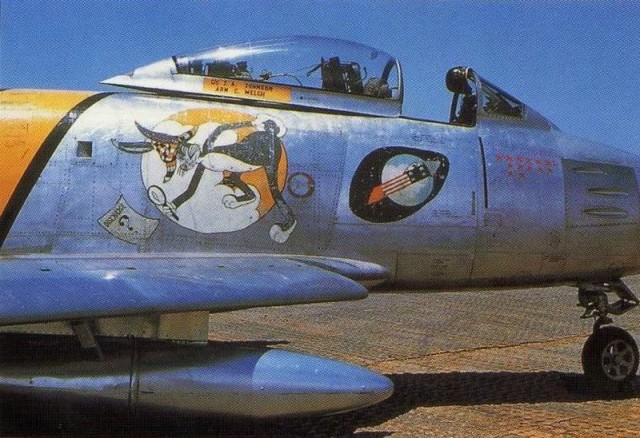 Risner’s F-86; notice the nose art.
Risner’s F-86; notice the nose art. On September 15th, Risner was assigned, under a call-sign “John Red Lead”, to escort F-84 Thunderjet fighter-bombers attacking a chemical plant on the Yalu River, near the East China Sea. During this operation, Risner overflew the Antung military airport in the neighboring China. Fighting one MiG at nearly supersonic speeds at ground level, Risner pursued it down a dry riverbed and across low hills to an airfield 35 miles inside China.
He pursued the MiG whose pilot radioed ahead about the incoming US jet fighter. In a manner of seconds, the Chinese AA guns were manned and firing on Risner, who managed to evade them as much as it was possible. He continued his pursuit of the already severely damaged MiG. Risner waited for his moment since he was running low on ammunition at this point. He pulverized the MiG with the rest of his 50 CAL rounds. This was all happening at the Chinese airport.
The MiG lost its canopy and was set on fire, while “John Red Lead” continued to chase it in low altitude. He shot it down between the Chinese hangars and the enemy aircraft smashed into other parked MiGs, destroying them.
One of the flight members, 1st Lieutenant Willard P. Dunbar reported afterwards that the MiG pilot was a hot-headed Russian who shook his fist in revolt, towards Risner, just moments before crashing. On return to base, Risner’s wingman, 1st Lieutenant Joseph Logan was hit in his fuel tank above the Antung airport. Then Risner proved his daring and heroic nature once again.
They were flying above open sea. He attempted to push Logan’s aircraft back to base by pushing the nose his own plane into the tailpipe of Logan’s while his jet was floating in the air with its engine turned off.
The plan was to push Logan’s plane close to the island of Cho Do, where the US Army kept a helicopter outpost. Risner’s vision over the scene was heavily obscured by the jet fuel and hydraulic fluid that spewed out of Logan’s aircraft right onto Risner’s canopy. He was forced to break contact.
Logan had to bail out and just before he did, he radioed to Risner: “I’ll see you at the base tonight.”
Even though he managed to eject fairly close to the shore of the Cho Do island and was a solid swimmer, Logan got entangled in his parachute and drowned in the sea. Risner shut down his own engine in an attempt to save fuel, but eventually his engine flamed out, and he glided to a deadstick landing at Kimpo.
Soon after this operation, James Robinson Risner became a fighter ace by downing his fifth MiG. Until the end of the Korean campaign, Risner flew 108 combat missions and shot down eight enemy MiG jets in total.
Vietnam War
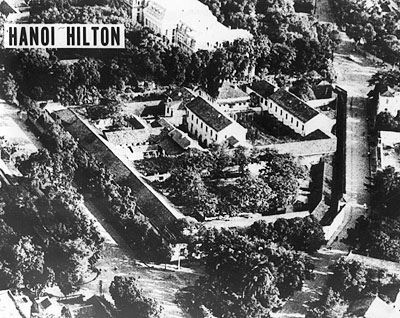
Not only that he survived this dreadful experience, but he helped others survive it too. Among the men captured in Hanoi was also Captain James Stockdale, who would later become a Vice-Admiral in the Navy. Another POW, Commander Everett Alvarez Jr. noted:
“We were lucky to have Risner. With (Captain James) Stockdale we had wisdom. With Risner we had spirituality.”
Risner was promoted to colonel after his capture, with a date of rank of November 11, 1965. He was part of the first group of prisoners released in Operation Homecoming on 12 February 1973 and returned to the United States. In July 1973 USAF assigned him to the 1st Tactical Fighter Wing at MacDill Air Force Base, Florida, where he became combat ready in the F-4 Phantom II.
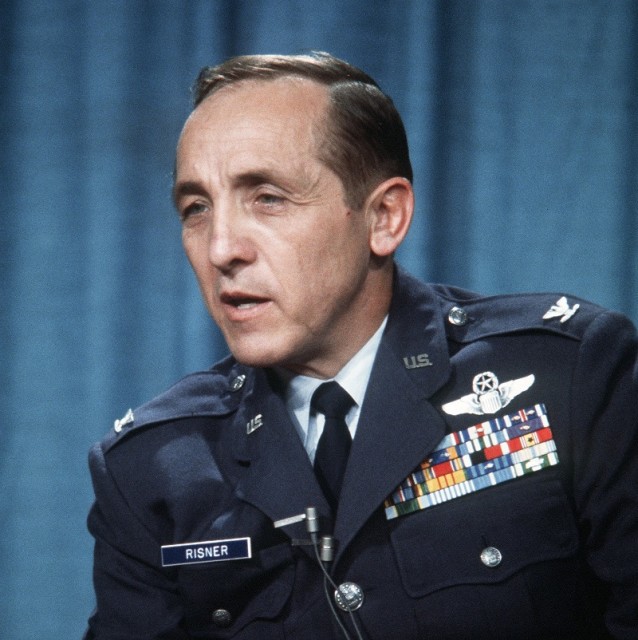
Former POW and U.S. Air Force COL Robinson Risner, (Captured 16 Sep 65) answers questions at a press conference. COL Risner was released by the North Vietnamese in Hanoi on 12 Feb 73.
Risner was later transferred to Cannon Air Force Base, New Mexico, in February 1974 to command the 832d Air Division, in which he flew the F-111 Aardvark fighter-bomber. He was promoted to Brigadier-General in May 1974. On 1 August 1975, he became Vice Commander of the USAF Tactical Fighter Weapons Center at Nellis Air Force Base, Nevada and retired from the Air Force on 1 August 1976.
At his death, which occurred as a consequence of a sudden stroke on October 22, 2013, General Mark A Welsh III stated: “Brig. Gen. James Robinson “Robbie” Risner was part of that legendary group who served in three wars, built an Air Force, and gave us an enduring example of courage and mission success…Today’s Airmen know we stand on the shoulders of giants. One of ‘em is 9 feet tall…and headed west in full afterburner.

No comments:
Post a Comment